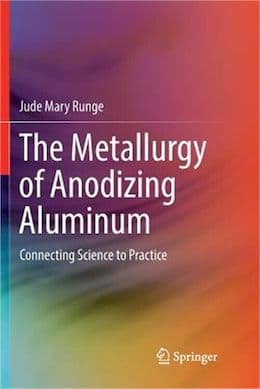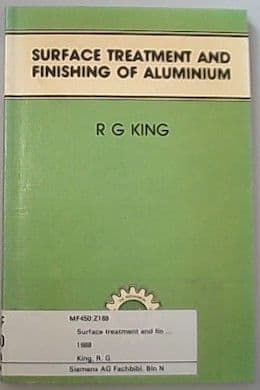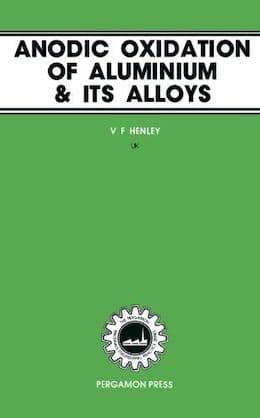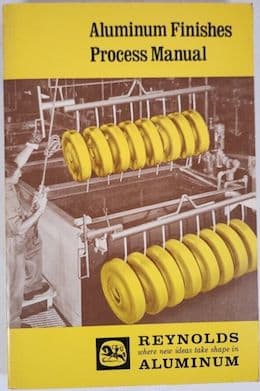
-----
Understanding aluminum anodizing theory
Looking for a practical introduction instead?
Please see our "Aluminum Anodizing: Introduction & FAQs"
Q. As a part of the Great Resignation I now have more time to be curious. I stumbled on the site where it explains how to anodize using sodium bisulphate and have been very successful creating some art pieces. I also have undergrad training in chemistry, so I am curious about the detailed chemistry.
In all the explanations and diagrams it shows oxygen being produced at the Anode (the Al piece) and H being produced at the cathode and simply show Al oxide being produced. But, there has to be more to the chemistry. Why must it be done in sulfuric acid and its half neutralized cognate sodium bisulphate? Why not nitric or hydrochloric?
Another question I've come up with, is how is the setup for anodizing different from electropolishing where the workpiece is also connected to the anode but the solution is other than sulfuric acid. Although the ⇦[this on
eBay,
AbeBooks, or
Amazon
affil links]
shows formula for electropolishing with sulfuric acid in it.
Which bring me to this third question. ASTM shows a sodium carbonate solution for electropolish. Sodium carbonate in water produces NaOH and carbonic acid. So essentially it is NaOH as an electropolishing solution. But my question is this, why does creating a 1N solution of sodium carbonate seem not to be the same as 1N solution made from NaOH, it seems much weaker. Is there something with the carbonic acid acting as a buffer?
Any ideas? So far my google search and reading lots of stuff has not helped me answer these questions!
- New york new york
April 19, 2022
for Shops, Specifiers & Engineers

avail from eBay, AbeBooks, or Amazon

avail from eBay, AbeBooks, or Amazon

avail from eBay, AbeBooks, or Amazon

avail from eBay, AbeBooks, or Amazon

avail from eBay or Amazon
(as an Amazon Associate & eBay Partner, we earn from qualifying purchases)
A. Hi W.,
Other solutions are used for anodizing when different properties are wanted, including chromic acid, phosphoric acid, tartaric acid
⇦ on
eBay
or
Amazon [affil link] , oxalic acid, and several others. Sulfuric acid is the most widely used because it generates the most widely useful anodized layers. Nitric acid is rarely used in electrolytic processes because it is a powerful oxidizing material, resisting the electrochemical work effort and because it is prone to releasing dangerous NOx-ious gasses, but it is not unheard of. Hydrochloric is not used because it is not dibasic, and only acids that are dibasic and which exhibit certain specific other parameters seem capable of generating useful anodized films.
If you have time on your hands try to get to a library that has Wernick, Pinner, & Sheasby. It includes very deep theory and explanations of how the oxide film forms the way it does & why, and it covers & summarizes just about every study ever done on the subject of aluminum anodizing and electropolishing and will answer every question about theory that you can come up with :-)
Luck & Regards,

Ted Mooney, P.E. RET
Striving to live Aloha
finishing.com - Pine Beach, New Jersey
Ted is available for instant help
or longer-term assistance.
A. Hi W. Anodizing can be done in other acid baths including but not limited to chromic or oxalic acids; hydrochloric is out due to the destructive effect that even contamination-level chlorides have on anodized aluminum substrates.
All this being said, as you have identified yourself as an artist rather than a commercial shop, be sure in advance that you are permitted to dispose of the waste products from your studio.
Sincerely, a lab rat who wasn't eligible for the luxury of a "great resignation" due to having been an essential blue collar worker all along.
I hope that you can understand that making the "Great Resignation" an important part of your introductory post here might hit a bit off-kilter in a community of working technicians and process engineers with a huge range of backgrounds, from purely technical to purely academic.
Anodizing isn't a default profession that one falls into when the first choice fizzles. It's a field where doctoral degrees are frequently awarded for work in its advancement.
If you're just getting started, check out Mr. Probert's book. It's a solid education. If you've read and memorized it, and have problems, and want to get really twitchy, the Brace books that I think you have to order from a print shop in Italy now are really good, if a bit heavily and painfully academic.

Rachel Mackintosh
Lab Rat / WWTF - Greenfield MA
![]() I taught for a university. When COVID came and state revenues crashed, I was one of the first to be laid off at the end of the semester. So more the case of , "you can't lay me off! I quit!", a semi forced retirement.
I taught for a university. When COVID came and state revenues crashed, I was one of the first to be laid off at the end of the semester. So more the case of , "you can't lay me off! I quit!", a semi forced retirement.
That I have offended anyone, my apologies. My thanks to anyone who might have read and considered an answer. I will look for the answers in those volumes recommended.
Aloha.
- New york new york
Ed. note: In this public forum which is readable by anyone in the world it is impossible to never take offense, and to never say something that offends someone. All we can do is try our best to ...
"Practice kindness relentlessly" -- Lady Gaga
"Speak your truth quietly and clearly; and listen to others, even the dull and the ignorant; they too have their story." -- The Desiderata
Hi again ... it's funny, I abandoned Academia about ten years ago for Manufacturing, under possibly similar circumstances... in my case, as a grant-funded hourly lab tech who was quickly axed when the grants ran dry, and then picked up by a new lab, over and over and over. Until it was simply too much. Maybe it's a long work history of feeling a bit disposable, and now being inundated by stories of glorious journeys of self discovery all over the news, that's got my hackles up so badly (too badly?) about the current media obsession.
I suppose that every resignation has a back story worth hearing first.
I seriously hope you build the setup for what you are trying to do... one interesting thing to note is that some of the potential baths-those using organic acids- may successfully and legally be disposed of simply by neutralization, assuming you haven't picked up too much chromium from your substrate... aluminum buildup being the limiting factor, it's unlikely.
Sulfuric is still the easiest, from the point of view of resources available to troubleshoot and test it.
Heartfelt best wishes for your project.

Rachel Mackintosh
Lab Rat / WWTF - Greenfield MA
May 11, 2022
⇩ Related postings, oldest first ⇩
Q. I work for an anodizing company in Austin Texas. We have been in business for about 2 1/2 years and I am the lead anodizer there doing custom work in the paintball industry but we also do some work with automotive parts.
I've never been to college for anodizing and have only found basic information on the internet and in some pamphlets. From what I've learned I've just built on with trial and error and have gotten very good. What I want to know is where I can get information either on the internet or in a book about the science of anodizing. Every book I looked up about anodizing has been out of print. What I'm most interested in is what is happening on the molecular scale. Any information you may have would be greatly appreciated.
Anodizing - Austin, Texas, United States
2004
A. Congratulations on your eagerness to learn, Kevin.
You are right about so many books being out of print. Unfortunately, the entire infrastructure of the surface finishing industry is rapidly collapsing, not only in America but throughout the world. There are, however, still some very good sources for the information you seek. You should join the American Electroplaters and Surface Finishers Society (NASF), one benefit of which is a subscription to their monthly journal Plating & Surface Finishing, which includes many in-depth articles each year on anodizing. They also offer training courses and home learning modules. Metal Finishing magazine is another monthly which you'll find helpful--and a subscription includes "The Metal Finishing Guidebook and Directory".
The best book for theory is probably:
"The Surface Treatment and Finishing of Aluminum and Its Alloys" [on
AbeBooks or
Amazon or
eBay affil links] by S. Wernick, R. Pinner, P.G. Sheasby.

Ted Mooney, P.E.
Striving to live Aloha
finishing.com - Pine Beach, New Jersey
Ted is available for instant help
or longer-term assistance.
Ed. update April 2022: The described collapse of the existing information infrastructure was real :-(
Neither Plating & Surface Finishing, nor Metal Finishing magazine and its Guidebook exist anymore.
A. You can check the European Aluminium Association:
https://www.alueurope.eu/talat
Once you are in the Talat Website Click on Item # 5:
"Aluminium Surface Technology". You will find a wealth of information.
Respectfully:
- Kalamazoo, Michigan, USA
Ed. update: Although www.alueurope.eu still exists, that URL is broken, and their search engine shows no entries at all for "anodising".
![]() Thanks for the excellent link, Jahan.
Thanks for the excellent link, Jahan.
Regards,

Ted Mooney, P.E.
Striving to live Aloha
finishing.com - Pine Beach, New Jersey
Ted is available for instant help
or longer-term assistance.
Q, A, or Comment on THIS thread -or- Start a NEW Thread
